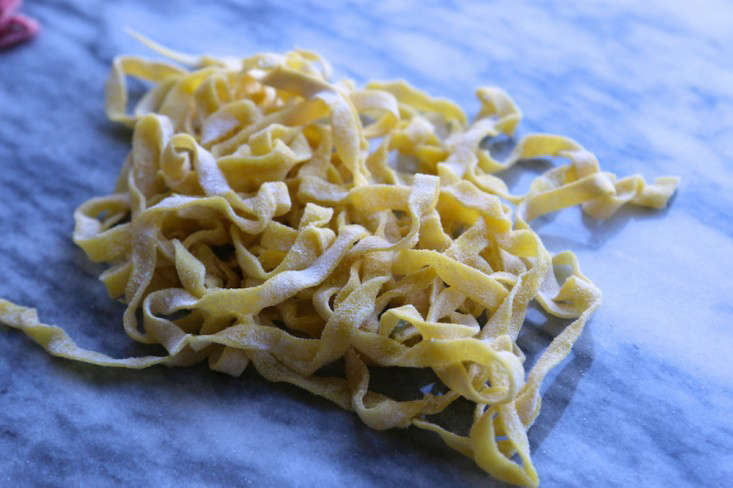I’m not new to fresh pasta; my mom makes it, several Italian friends make it, and we have the process down well enough that we’re reaching for flour just as we’re starting to get hungry for dinner. But I like a challenge, and each time I say the same thing: “Next time, let’s make colored pasta.”
I finally took the leap, and coloring pasta with natural ingredients is far easier than I thought. I did some Googling and found myriad coloring strategies–some even using artificial food coloring (the horror!). But most agreed on a simple concept: reduce a coloring agent to two tablespoons of liquid or wet paste, and add to your pasta when adding the rest of the wet ingredients.
One thing to note: This isn’t really for flavor, it’s for color. I wouldn’t pair the beet pasta with a sauce that would clash with beets, but even that may be all in my head: you really can’t taste the beets at all.
Read on for step-by-step instructions:
Photography by Meredith Swinehart.

Above: Fresh pasta begins with eggs, olive oil, and salt inside a ring of flour.
If you’ve never made fresh pasta before, try it. Just don’t start when you’re already hungry for dinner. It’s a bit of a process the first time but, like everything, gets exponentially faster with practice. As a primer, I recommend a recipe from Linda Scheibal of Pasta Poetry: see Perfect Pasta with a Magic Ingredient on Remodelista.
Above: To flatten and cut the dough into linguine, I used a Marcato Atlas 150 Pasta Machine with Motor; $169.95 on Amazon. Made in Italy, it’s the same brand of choice as Christophe Lemaire’s partner Sarah-Linh Tran.

Above: The overarching concept for coloring pasta: find something with a strong natural color, roast it, boil it, or smash it, and mix it into the pasta dough. I used beets, saffron, and fresh herbs.
Beets: For red pasta, roast a beet in the oven (at 425 degrees for approximately an hour). When cool enough to handle, peel a piece of the beet and puree in a food processor or high-speed blender, adding a splash of very hot water. Continue blending, scraping down the sides of the bowl, until you have a very fine puree; you don’t want any chunks of beet in the dough.
Saffron: For yellow pasta, place a pinch of saffron threads into a small bowl and add two tablespoons of very hot water. Let the saffron soak for 15 minutes. Most recipes end after recommending you remove the saffron threads from the dye. This works, but the color isn’t nearly as vibrant as I want it. My tweak? I poured more hot water over the saffron (just a teaspoon or so) and ground it with a mortar and pestle. This succeeded in drawing a lot more color out of the saffron, and the dye was much more vibrant. Next time I do this, I’ll go straight to the mortar and pestle.
Fresh Herbs: For a consistent ribbon of green, most recipes call for spinach. But I like the flecked look of herbs, and I wanted the flavor. So I blended a mix of rosemary, oregano, and Italian parsley in a mini food processor with a splash of very hot water.

Above: Add two tablespoons of the coloring puree with the liquid before mixing. Here, saffron water in the liquid well.

Above: When you add coloring, you are changing the ratio of liquid to flour in the basic recipe, so consider adjusting accordingly. I did not, but I also know what fresh pasta dough should feel like, and I’m comfortable adding more flour or water as needed. Some recipes suggested swapping one large egg for two medium eggs to reduce the initial dose of liquid in the recipe.
If your dough is dry, as pictured above, your recipe will call for adding more water, a little at a time, to moisten the dough. When making colored pasta, don’t add water: add more of your puree instead.

Above: Why the dark photo? Because, well, even I forgot how long it takes to make fresh pasta; I made four pounds of pasta, and by the time I’d colored each pound and run it all through the machine, the sun had set.

Above: After I’d begun cutting the pasta, I realized I hadn’t accounted for a drying rack. (See DIY: Instant Pasta Drying Rack on Remodelista, coming Friday.) The solution? Let the pasta dry in small piles, each generously floured. Your final product won’t be dried flat and neatly folded onto itself, but it will taste just as good.

Above: The saffron pasta was the mildest, in both color and flavor. I couldn’t taste the spice at all, but the pasta boils into a beautiful yellow color.

Above: The earthy flavor of beets is one of the hardest flavors to mask, so I was surprised to discover that I couldn’t taste the beet at all.
I paired the beet pasta with a radicchio and gorgonzola sauce from new cookbook Bitter. Stay tuned for the recipe, coming Thursday.

Above: The herb pasta had the most flavor. I paired it with more herbs–Walnut Sauce for Pasta (with walnuts, ricotta, and basil)–also from Bitter.

Above: I hadn’t intended to make the tricolore, but since the Italians gave us pasta as we know it today, viva l’Italia.
Keep playing with pasta: See The Magic Pasta Ingredient, The Healthiest Spaghetti You’ll Ever Eat, and coming Friday on Remodelista, DIY: Instant Pasta Drying Rack.










Have a Question or Comment About This Post?
Join the conversation